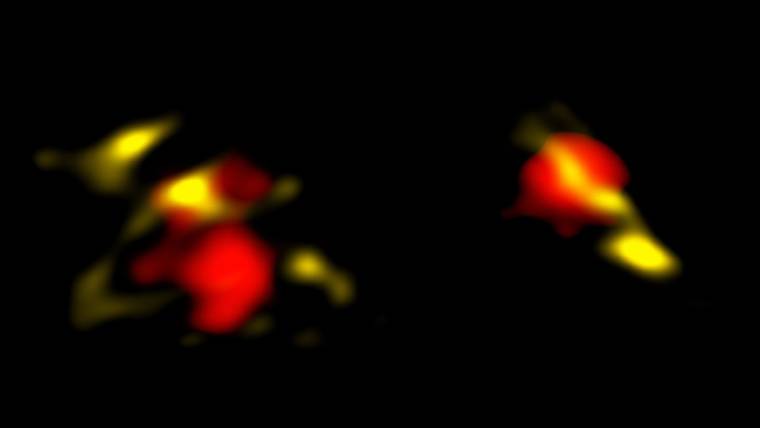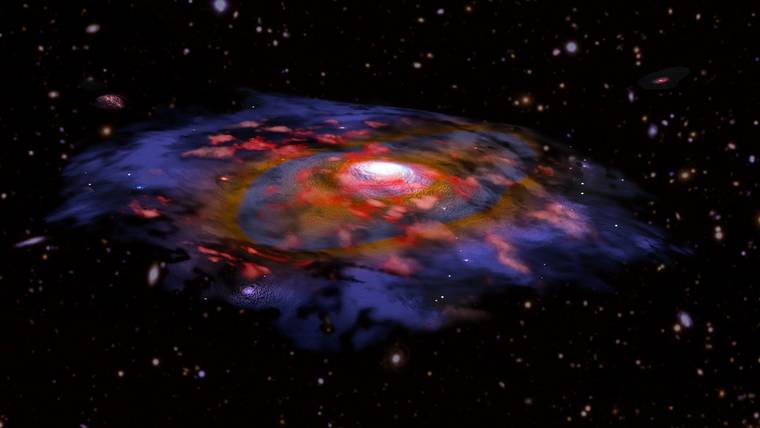In the first and largest multi-wavelength survey of distant galaxies in the early universe ever conducted, an international team of astronomers has discovered that massive galaxies were already much more mature in the early universe than previously expected.
The survey, called ALPINE (the ALMA Large Program to Investigate C+ at Early Times), aimed at measuring the gas and dust in 118 distant galaxies, and involved the use of two Maunakea Observatories – W. M. Keck Observatory and Subaru Telescope – to obtain crucial measurements in the optical wavelength of galaxies over 12 billion light years away. That means the team looked back in time at these galaxies as they were just 1 to 1.5 billion years after the Big Bang when they were experiencing a growth spurt. To their surprise, they found galaxies might evolve faster than expected.
A large portion of the ALPINE survey results are highlighted in eight articles published today (October 27, 2020) in a special edition of the journal Astronomy &Astrophysics.
“We didn’t expect to see so much dust and heavy elements in these distant galaxies,” said ALPINE co-principal investigator Andreas Faisst of the California Institute of Technology.
Galaxies are considered more “mature” when they contain a significant amount of dust and heavy elements (defined by astronomers as all elements heavier than hydrogen and helium), which are considered to be by-products of dying stars. But galaxies in the early universe have not had much time to build stars yet, so astronomers expect them to be dust-poor and contain a low amount of heavy elements. They also generally expect them to look like train wrecks because early galaxies often collide with each other.
Instead, the team found many of the galaxies in the ALPINE survey showed relatively grown-up features, particularly a diversity in their structures including the first signs of rotationally supported disks, which may later lead to galaxies with a spiral structure as is observed in galaxies such as our Milky Way.
“We see many galaxies that are colliding, but we also see a number of them rotating in an orderly fashion with no signs of collisions,” said co-principal investigator John Silverman of the Kavli Institute for the Physics and Mathematics of the Universe in Japan.
Multi-wavelength studies are needed to get the full picture of how galaxies form. In addition to data from Keck Observatory and Subaru Telescope, the team also collected optical measurements from VISTA, Hubble, and VLT, as well as analyzed the galaxies in infrared using Spitzer and in radio wavelengths with the Atacama Large Millimeter/submillimeter Array (ALMA) revealing the places of star formation hidden by dust.
A majority of the galaxies in the ALPINE survey were chosen from a robust catalog of ultra-distant objects with high-quality spectra obtained using Keck Observatory’s Deep Imaging Multi-Object Spectrograph (DEIMOS).
“Without Keck, ALPINE would not have been made possible,” said Brian Lemaux, an astronomer in the Department of Physics and Astronomy at University of California, Davis and co-investigator of ALPINE. “Much of the science that has resulted from the survey relies heavily on Keck data, which allowed us to target these distant galaxies with ALMA and see what was hidden by dust.”
To help solve the mystery as to how the galaxies grew up so fast and what may cause some of them to undergo collisions, in addition to ALPINE, astronomers, led by a team at UC Davis, are also conducting another survey called C3VO; by observing the large-scale environments of ALPINE and other galaxies in the young universe using Keck Observatory and Subaru Telescope, they hope to see the early stages of the formation of galaxy clusters. Such studies into the early universe provides astronomers a deeper understanding of how the galaxies that we see today are formed.
All ALPINE papers are dedicated in memory of Olivier Le Fèvre, principal investigator of ALPINE, who passed away in June.




